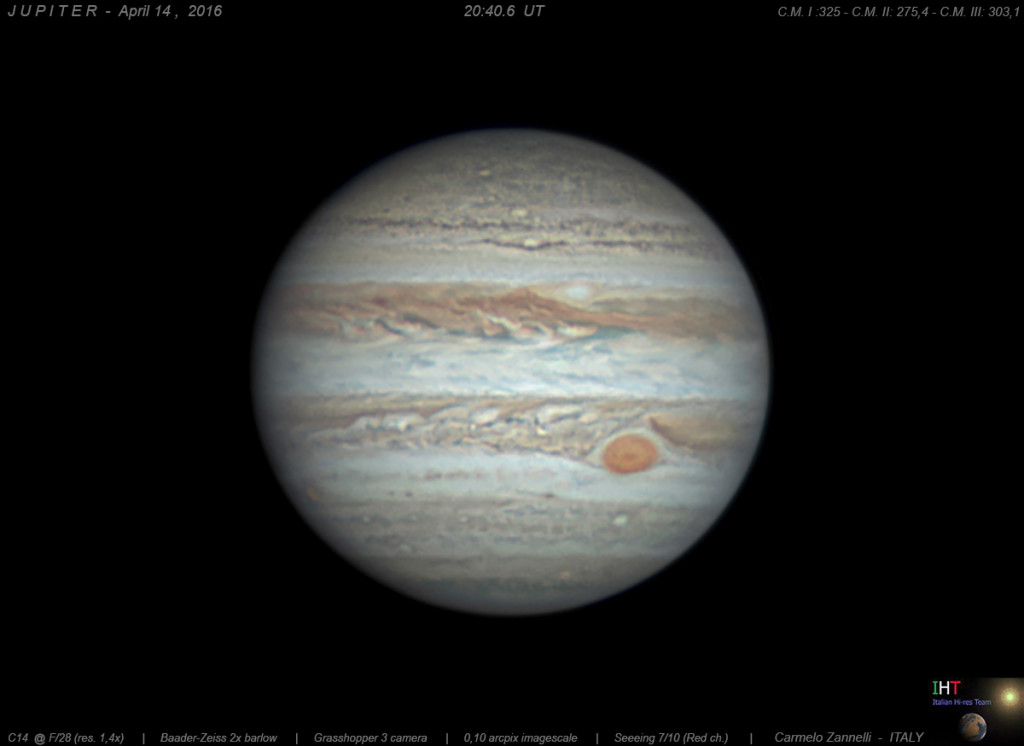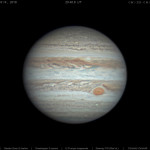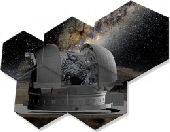Italiano: (for English, please read more below)
Rieccomi con una immagine di Giove dello scorso 14 aprile, questa volta una piccola finestra di buon seeing, della durata di pochi minuti, mi ha permesso di avere dei dati di maggior evidenza con maggior dettaglio della superficie.
La sessione di ripresa è iniziata alle 21:37 locali in condizioni di seeing molto scarse (circa 4/10 della scala Pickering), per migliorare sempre più fino alle 22:40 quando ha raggiunto il picco di stabilità del jetstream locale, restituendomi una buona visibilità in alta risoluzione per una manciata di minuti, per poi peggiorare fino alle 23:15 in cui ho deciso di terminare la sessione di ripresa.
La “Grande Macchia Rossa” è molto ben evidente, il dettaglio di maggior spicco in questa immagine, il cui vortice anticiclonico – in senso antiorario – si può facilmente apprezzare e alcuni piccoli dettagli dentro essa (oltre al suo centro più marcatamente rosso) sono abbastanza evidenti. La corrente a “scia”, della grande Macchia Rossa, è sempre molto turbolenta.
Una struttura più scura nella STB Ghost, è vicina alla predetta GMR (nella nomenclatura internazionale GRS) e il piccolo ovale rosato, facente parte dell’STB ghost, risulta ancora evidente (anche maggiormente in immagini a miglior dettaglio di alcuni altri colleghi astroimagers).
L’ovale (attualmente col centro bianco) chiamato Spot Z è da poco passato al meridiano centrale, avvinghiato alla componente nord della NEB (North Equatorial Belt) o appunto Banda Equatoriale Nord, mentre l’ovale rossastro all’interno della SPR (South Polar Region) è sempre molto evidente, essendosi chiaramente spostato in longitudine rispetto alla GRS (Grande Macchia Rossa). L’Ovale BA, infine, di colore rossastro anch’esso, sorge sul bordo sinistro dell’immagine, dalla parte oppposta della Grande Macchia Rossa.
Questa immagine è frutto della somma di “soli” 1620 frames acquisiti con la camera Pointgrey Grasshopper 3 – USB3 – a 30 fps e in formato file .ser (il tipico formato raw delle telecamere planetarie), dove ho dato la priorità alla qualità del segnale (nel tipico rapporto S/N o segnale/rumore) piuttosto che alla quantità di frames acquisiti. Ciò mi ha permesso, con seeing stabile, una qualità di dettaglio più spinto, anche se in così pochi frames sommati. Per contro, ammetto di aver un pò “strapazzato” l’immagine finale per tirar fuori tutti i minimi dettagli che essa era in grado di dare.
Grazie per l’attenzione e…. “ad maiora semper”… 😉
Carmelo Zannelli
Palermo city
Dettagli tecnici:
Celestron C14 Starbright ad F/28 – Baader-Zeiss barlow 2X – Filtri RGB Baader – Camera PGR Grasshopper3 (23S6M-C) – Ruota portafiltri Atik EFW2 – Seeing 7/10 per il canale Rosso.
English:
Here I’am again with my last Jupiter image of last April 14th, in a short window of good seeing (about 5 minutes) which permits to me to capture a fairly good data of Jupiter surface details.
The Great Red Spot is clearly prominent, the most prominent in this image, whose anticyclonic vortex you can easily appreciate and some small details are visible in it (moreover, its center is more markedly red). The current wake of the great Red Spot, is always very turbulent.
A darker structure in STB Ghost, approaches the GRS (Great Red Spot) and the rosy small oval, part of the STB ghost, is still evident (even better in best detailed images of some other colleagues astroimagers).
The white oval spot called Spot-Z has just passed the central meridian, attached to the northern part of the NEB (North Equatorial Band), while the reddish oval inside the SPR (South Polar Region) is always very clear, He is clearly having moved in longitude from the GRS. Oval BA, finally, rise on the left edge of the image, from the opposite side of the GRS.
This image is the result of the stack of “just” 1620 frames acquired with my Pointgrey Grasshopper 3 – USB3 – camera at 30 fps and .ser file format (the camera’s raw format), where I gave priority to the quality of the signal (in the typical S/N ratio) rather than to the amount of frames acquired. This allowed me a more stringent quality of detail, although in a relatively few frames so summed. On the other hand, I admit to having a bit “scrambled” the final image to bring out all the minute details which it was able to give me.
Thanks for your attention and …. “ad maiora semper” … 😉
Carmelo “Mel” Zannelli
Palermo – Sicily – ITALY
Technical details:
Celestron C14 Starbright @ F/28 – Baader-Zeiss barlow 2X – Baader RGB filters – PGR Grasshopper3 (23S6M-C) camera – Atik EFW2 filterwheel – Seeing 7/10 for Red light.



One Comment
Bellissima Carmelo… veramente grnade.
Ciao, Mario